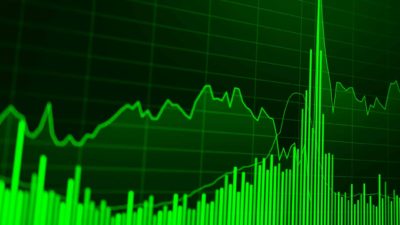The S&P/ASX 200 Index (ASX: XJO) has just endured its worst week since October last year, in a drama-filled week for the ages. Despite this, the index ended up giving investors its fourth month of positive momentum in a row.
As per usual, it was ASX banks and resources shares that were behind the week's poor performance. Lower iron ore prices and a 'risk-off' turn in investor sentiment contributed to last week's falls.
But all of this was overshadowed by one of the strangest and most-FOMO inducing events the markets have seen in living memory. It all revolved around a formerly little-known United States company called GameStop Corp (NYSE: GME). We covered some of the complicated machinations that took place around this company here, but following is what happened in a nutshell (and why everyone was talking GameStop last week).
GameStop stops the market in its tracks
Basically, GameStop was perceived as a sunset, dying company due to its 'old-world' business model of selling gaming consoles and games through physical stores (a market that is fast moving online). GameStop owns a large network of retail gaming stores around the world (including the EB Games chain in Australia).
As a result of this perception, GameStop has long been at the top of the list of 'most-shorted stocks' over in the US, as a large number of institutional fund managers and hedge funds held GameStop stock in short positions. That essentially means these investors were all betting that GameStop stock would trend lower over time as its business model dries up.
That's where this whole palaver started. The thing was, a large number of investors on the Reddit community known as 'WallStreetBets' noticed this situation in which a relatively small company had many large, well-funded short bets against it. These investors decided if they banded together to try and push up the GameStop share price, it would result in something called a 'short-squeeze'.
This occurs when the shorter has to exit their short position due to the rising stock price of the company in question. When a number of large short positions have to cover their losses at the same time, it can result in a massive market distortion where there are more buyers than sellers in the market.
And that's exactly what happened. This 'short-squeeze' resulted in GameStop shares exploding over just a few days. At the start of last week, GameStop shares were trading as low as US$68. On Thursday morning (US time), the GameStop share price was as high as US$483. A ~640% return? Enough said. That's why the markets were abuzz with this news. It's not often a bunch of retail, 'amateur' investors can exploit large fund managers like this.
How did the markets end the week?
As we discussed earlier, the ASX 200 did not have a top week. Monday was the only day the index had a day in the green, with a rise of 0.36%. Tuesday was a public holiday, so the markets were closed. Then Wednesday, Thursday and Friday all brought sell-offs, with losses of 0.65%, 1.93% and 0.64% respectively. Since the ASX 200 started the week at 6,800.4 points and finished up 6,607.4 points, it recorded a nasty 2.8% loss for the week.
Meanwhile, the All Ordinaries Index (ASX: XAO) didn't fare any better, starting at 7,078.9 points and finishing up at 6,870.9 points, also down 2.8% for the week.
Which ASX 200 shares were the biggest winners and losers?
It's now time to have a gossip over last week's biggest winners and losers. So put the tea on and we'll start with the losers:
| Worst ASX 200 losers | % loss for the week |
|---|---|
| IOOF Holdings Limited (ASX: IFL) | (16.6%) |
| Ampol Ltd (ASX: ALD) | (14.9%) |
| Lynas Rare Earths Ltd (ASX: LYC) | (14%) |
| Kogan.com Ltd (ASX: KGN) | (13.8%) |
Leading the losers last week was wooden spooner and wealth manager IOOF. IOOF was in the firing line after a not-too-well-received quarterly update from the company. IOOF told the market it managed to record a net outflow of $400 million in the quarter, despite a rapidly rising market.
Fuel retailer Ampol was also on the nose. There was no major news out of Ampol apart from a notice that the company was wrapping up its share buy-back program. Investors apparently would have rather kept it rolling.
Rare earths processor Lynas wasn't far behind. This company was on our winners' list last Monday after announcing a new deal with the US government. There was no major news out last week, so we can probably put this move down to some profit taking during a down week for the market.
Finally, we have investor favourite (at least until last week) Kogan.com. Kogan was also the victim of a quarterly update. This one outlined how Kogan increased its sales by 196% and its earnings by 140%. Since this wasn't quite as impressive as Kogan's previous quarter, investors decided to hit the sell button. The company's declaration it was struggling to meet demand perhaps didn't help (although that's not usually a bad thing).
Now with the losers out of the way, let's check out the week's winners:
| Best ASX 200 gainers | % gain for the week |
|---|---|
| Unibail-Rodamco-Westfield (ASX: URW) | 22.4% |
| IDP Education Ltd (ASX: IEL) | 12.6% |
| Domain Holdings Australia Ltd (ASX: DHG) | 8% |
| Treasury Wine Estates Ltd (ASX: TWE) | 7.8% |
Leading the winners last week was real estate investment trust (REIT) Unibail-Rodamco-Westfield, despite no major news out of the company. Interestingly, URW was a heavily-shorted share on the ASX, so it's possible that some short-sellers got spooked by the whole GameStop saga and cashed out early to avoid the kind of burn GameStop shorters experienced last week. The same could arguably be said of Treasury, which investors have been bearish on ever since China effectively halted Aussie wine imports.
IDP Education, in contrast, appeared to be benefitting from improving sentiment, fuelled in part by some positive broker notes. Domain was in a similar boat, spurred on by rising house prices across the country (particularly in Sydney and New South Wales).
A wrap of the ASX 200 blue chip shares
Before we go, here is a look at the major ASX 200 blue chip shares as we start yet another week on the ASX boards:
| ASX 200 company | Trailing P/E ratio | Last share price | 52-week high | 52-week low |
|---|---|---|---|---|
| CSL Limited (ASX: CSL) | 45.59 | $271.72 | $342.75 | $242.67 |
| Commonwealth Bank of Australia (ASX: CBA) | 20.42 | $83.51 | $91.05 | $53.44 |
| Westpac Banking Corp (ASX: WBC) | 33.16 | $21.13 | $25.96 | $13.47 |
| National Australia Bank Ltd (ASX: NAB) | 21.69 | $23.54 | $27.49 | $13.20 |
| Australia and New Zealand Banking Group Ltd (ASX: ANZ) | 19.58 | $23.71 | $27.29 | $14.10 |
| Fortescue Metals Group Limited (ASX: FMG) | 11.01 | $21.79 | $26.40 | $8.20 |
| Woolworths Group Ltd (ASX: WOW) | 44.38 | $40.86 | $43.96 | $32.12 |
| Wesfarmers Ltd (ASX: WES) | 38.11 | $54.61 | $55.57 | $29.75 |
| BHP Group Ltd (ASX: BHP) | 21.49 | $43.56 | $47.54 | $24.05 |
| Rio Tinto Limited (ASX: RIO) | 19.38 | $110.31 | $127 | $72.77 |
| Coles Group Ltd (ASX: COL) | 24.84 | $18.21 | $19.26 | $14.01 |
| Telstra Corporation Ltd (ASX: TLS) | 20.4 | $3.12 | $3.94 | $2.66 |
| Transurban Group (ASX: TCL) | – | $13.24 | $16.44 | $9.10 |
| Sydney Airport Holdings Pty Ltd (ASX: SYD) | 86.97 | $5.72 | $8.43 | $4.26 |
| Newcrest Mining Ltd (ASX: NCM) | 23.4 | $25.12 | $38.15 | $20.70 |
| Woodside Petroleum Limited (ASX: WPL) | – | $24.47 | $35.07 | $14.93 |
| Macquarie Group Ltd (ASX: MQG) | 19.85 | $131.40 | $152.35 | $70.45 |
| Afterpay Ltd (ASX: APT) | – | $135.10 | $151.22 | $8.01 |
And finally, here is the lay of the land for some leading market indicators:
- S&P/ASX 200 Index (XJO) at 6,607.4 points.
- All Ordinaries Index (XAO) at 6,870.9 points.
- Dow Jones Industrial Average Index (DJX: .DJI) at 29,982.62 points after falling 2.03% on Friday night (our time).
- Gold (spot) swapping hands for US$1,844.13 per troy ounce.
- Iron ore asking US$155.59 per tonne.
- Crude oil (Brent) trading at US$55.04 per barrel.
- Australian dollar buying 76.42 US cents.
- 10-year Australian Government bonds yielding 1.13% per annum.
That's all folks. See you next week!









